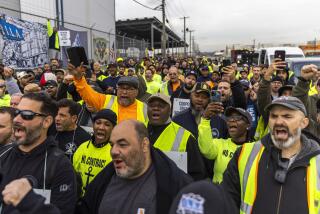Post-Quake Recovery of Kobe’s Port in Doubt
- Share via
KOBE, Japan — Eight months after a killer earthquake crippled Japan’s largest container port here, it is becoming clear that even $6-billion worth of repairs won’t bring back the harbor’s pre-quake prosperity.
“If Kobe relies only on recovery of the port, its future will be dark. We will have to think of other businesses” to revitalize its economy, said Tadashi Nakano, deputy general manager of harbor transportation for the Kamigumi Co., a leading stevedoring firm.
A third of the berths were put back into operation with provisional repairs and stevedores agreed to work 24 hours a day on two shifts and on Sundays so that “we can handle all of the previous tonnage,” Nakano said. “But only 63% of the pre-quake container business has come back.”
Moreover, a return to the pre-quake level “won’t be possible,” Nakano said flatly.
Even before the quake, rising costs, overseas relocation of factories and competition from ports in Taiwan and South Korea were eating into the business at Kobe, Japan’s biggest and the world’s sixth-largest container port, which for more than a century has nurtured this city of 1.5 million people.
An estimated 100,000 jobs owed their existence to the port and related businesses, which generated 40% of Kobe’s revenue, according to the Asahi newspaper. “Whether Kobe recovers or not will depend on a rapid return of Kobe Port to its original form,” the newspaper declared in an editorial in February.
Kenji Tomishima, marketing chief for the port, conceded that business won’t go back to pre-quake levels. But he emphasized that authorities intend to keep modernizing the port to stay abreast of trends in shipping and remain a keystone of Kobe’s economy.
Authorities have announced a plan to restore all of the port at a cost of $5.9 billion and modernize part of it for another $1.8 billion within two years. Then, in the eight years after that, another $7.7 billion will be invested to develop new port facilities.
About 80% of the cost of repairs will be subsidized by the central government.
Ultimately, the grandiose plans may be trimmed back. Nakano, for one, said the port’s 239 berths were not being fully utilized before the quake and he predicted that “about half of the old container berths won’t be needed any more.”
In recent years, Kobe had been suffering setbacks as a “hub” port, where cargoes were amalgamated for trans-shipment to final destinations, because of expensive fees, refusal of unions to work a 24-hour-a-day schedule or show up on Sundays and holidays, and declines in export cargo caused by Japanese manufacturers moving their factories overseas.
The quake, said Hiroshi Asano of Mitsui O.S.K. Lines Ltd. in Tokyo, accelerated the decline. About 20% of the port’s pre-quake container cargo “fled” to such ports as Pusan in South Korea and Kaohsiung in Taiwan, and won’t come back, he predicted. In both rival cities, port charges are about half of Kobe’s.
“When the earthquake made it impossible for ships to come to Kobe, the trend toward Pusan and Kaohsiung accelerated,” said Minoru Oda, shipping chief of Sumitomo Trading Co.
Kobe port also has been hurt by quake damage to highways leading to the harbor. Trucks carrying cargo face continuing delays, raising the cost of transporting goods to the docks. One of the main arteries, the Hanshin Expressway, a long section of which tilted over on its side in the earthquake, won’t be back in full service until the end of 1996.
“Owners are routing to Kobe only the amount of cargo they absolutely have to ship through the port,” Riku Ozaki, Kamigumi’s president, told the Kobe Newspaper.
By the end of August, the number of stevedores registered to work in Kobe dwindled to 6,030, Nakano said. A few years ago, nearly 10,000 were registered.
Not all of those registered were actually at work, however.
With the help of central government wage subsidies of up to $100 a day, about 1,000 stevedores remained on company payrolls even without working. Companies chipped in sums that, combined with the subsidies, covered up to 80% of regular pay, Nakano explained.
Average daily pay for a dockworker is $180. With bonuses, yearly wages amount to about $63,000, Nakano said.
Some companies, however, were losing the leeway to pay even their portion of subsidized wages. They were asking stevedores to quit and accept unemployment insurance payments from the government on the understanding that they would regain their jobs in the future, he said.
A precise number of unemployed workers was not known, the Kamigumi executive said.
Unions in Kobe shelved their annual demand for a pay increase this year while authorities reduced port fees as part of a labor-management effort to win back lost business, he said.
However, the real culprit in raising costs at the port has been yen appreciation, Nakano said. Five years ago, the exchange rate was 160 yen to the dollar, compared to 80 yen to the dollar earlier this year.
“Even without any increase in wages, costs doubled,” Nakano complained.
*
Megumi Shimizu of The Times Tokyo bureau contributed to this report.
More to Read
Sign up for Essential California
The most important California stories and recommendations in your inbox every morning.
You may occasionally receive promotional content from the Los Angeles Times.













